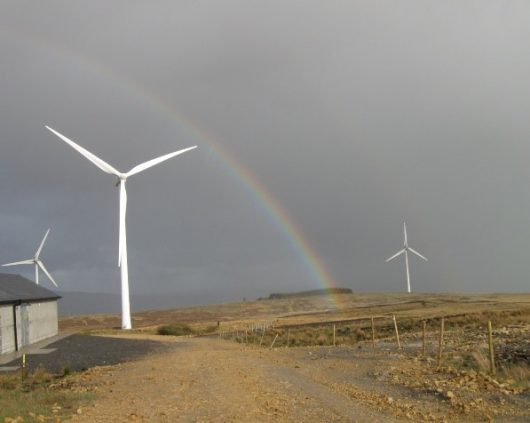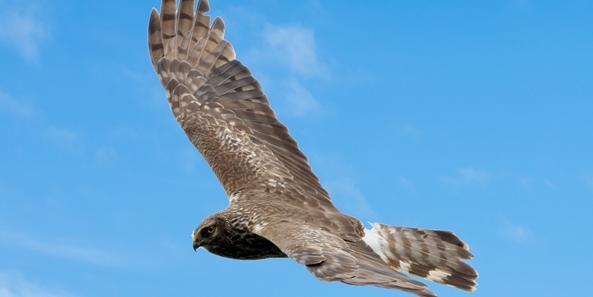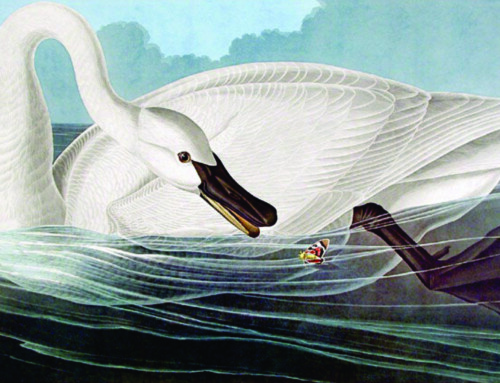Considerable spatial overlap and weak evidence for impact
LINKED PAPER
Hen Harrier Circus cyaneus population trends in relation to wind farms. Wilson, M.W., Fernàndez-Bellon, D., Irwin, S. & O’Halloran, J. 2016. Bird Study. DOI: 10.1080/00063657.2016.1262815. VIEW
One of the bird species for which potential impacts of wind energy development have been of greatest concern is the Hen Harrier, Circus cyaneus. Across Europe Hen Harrier populations are vulnerable in the face of both land-use change and direct persecution, with some evidence of regional declines over the past decade recorded for the small remaining Irish population, estimated at between 108 and 157 breeding pairs. The susceptibility of this rare bird to land use change presents significant challenges for its continuing conservation management, and compliance with legislation, in the context of on-going land use transformation of upland habitats. In particular, the effects on Hen Harriers of recent wind energy development, much of which has taken place in the upland areas occupied by Hen Harriers, are poorly understood.
The construction and operation of wind turbines can impact on Hen Harriers, as on other birds, in a range of ways. These include collision with turbines and displacement during construction and/or operation. However, observed impacts vary widely between different studies, and our understanding of the implications of these impacts on Hen Harrier populations remains poor. Population level studies have been scarce to date, even though this information is particularly important for regulators and practitioners whose aim is to balance renewable energy targets with effective nature conservation.

The WINDHARRIER project assessed the extent of the overlap between wind farms and breeding Hen Harriers in Ireland, and the potential impact of the wind energy sector on the Hen Harrier population between the years 2000 and 2010. Analyses were carried out at the level of 10km x 10km squares, using information from national Hen Harrier surveys carried out in 2000 and 2010, and from the Irish Wind Energy Association’s database of wind farms. The results revealed that, since 2000, wind turbines have been built in 28% of 10km x 10km upland squares that were occupied by breeding Hen Harriers (Fig. 1). This overlap between Hen Harriers and wind farms was, in large part, due to the fact that both are concentrated in areas of moderately high elevation. Although only 10% of land in Ireland is between 200m and 400m above sea level, this land holds 62% of Hen Harrier territories and 67% of Irish wind farms. High levels of overlap between breeding range and wind farms are not uncommon for raptor species (see BirdWatch Ireland‘s Bird Sensitivity Mapping tool). Such overlap has been reported for a number of vulture species in Spain and the Balkans.

The availability of data on Hen Harrier populations from the 2000 and 2010 National Surveys also afforded us the opportunity to investigate whether wind energy development has been related to changes in Hen Harrier breeding numbers. Using data from the 36 the squares where breeding Hen Harriers were recorded during the 2000 survey we found a marginally non-significant negative relationship between wind farm presence in a survey square and the observed change in the number of breeding pairs between the 2000 and 2010 national Hen Harrier surveys. This negative relationship was particularly strong for areas between 200m and 400m elevation.

The results of this study do not, in and of themselves, demonstrate any negative impacts of wind farms on Hen Harriers. However, the relationships found here suggest that careful planning is required to minimise the potential for wind energy development to impact negatively on conservation objectives. The findings of this study will be useful in providing guidance for future wind energy development in the identification of areas where development is least likely to conflict with Hen Harrier conservation. This is particularly important, as the overlap in spatial distribution of Hen Harriers and wind farms has been predicted to increase as the wind energy sector continues to grow throughout the Hen Harrier’s range to meet energy demands.
There are substantial political and economic pressures on regulators to allow wind energy developments to proceed in upland areas, many of which are important for Hen Harriers. This is the first study to assess the influence of wind energy development on Hen Harriers at such a large geographic and population scale and it sheds some light on how changes in Hen Harrier populations are related to this type of development, as well as to other aspects of geography and land use. However, further investigations will be required, as more data become available, to understand more fully the effects involved and the cumulative impacts of wind energy on Hen Harrier populations, in order to ensure that regulation of land use allows for effective conservation of Hen Harriers and development of energy sources aimed at reducing our dependence on fossil fuels.
References and further reading
Interactions between Hen Harriers and wind turbines (WINDHARRIER) Research Project. VIEW
Mc Guinness, S., Muldoon, C., Tierney, N., Cummins, S., Murray, A., Egan, S. & Crowe, O. 2015. Bird Sensitivity Mapping for Wind Energy Developments and Associated Infrastructure in the Republic of Ireland. BirdWatch Ireland, Kilcoole, Wicklow. VIEW
Ruddock, M., Dunlop, B.J., O’Toole, L., Mee, A. & Nagle, T. 2012. Republic of Ireland Hen Harrier Survey 2010. Irish Wildlife Manuals No. 59. VIEW
Ruddock, M., Mee, A., Lusby, J., Nagle, A., O’Neill, S. & O’Toole, L. 2016. The 2015 National Survey of Breeding Hen Harrier in Ireland. Irish Wildlife Manuals No. 93. VIEW
Image credit
Featured image: Hen Harrier, Circus cyaneus © Richard Mills
If you want to write about your research in #theBOUblog, then please see here.






